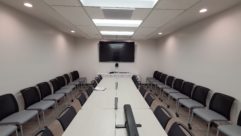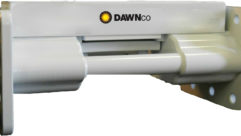A Plan of Attack
Apr 20, 1997 12:00 PM,
Michael Stocker
A well-written proposal is your best campaign for winning a project from your competitors. If ability to do the technical work were the only factor determining who wins and who loses a job, some people would win every bidding war they enter. Getting to the point where we are actually doing the work, however, requires us to travel through that gray area between design and marketing called “The Proposal.” And a sloppy proposal can kill your chances, making your company look sloppy, ill-prepared or just not very impressive. A well-written proposal, on the other hand, makes you look more professional and can help the client feel more comfortable by anticipating questions and concerns.
Think of the proposal as your battle plan to win the project and attack the job at hand. A proposal in its simplest form constitutes an agreement such as “Yeah, sure, I can do that for about a thousand bucks.” This type of agreement works well for simple jobs – moving a pile of rocks from point A to point B for example; in our technical field, however, jobs tend to be a bit more complex and require a better campaign.
Most large jobs in our industry are bid out through a careful series of qualified “request for quotation” and “invitation for bid” documents. These documents are often written by licensed design firms, reviewed by company legal departments and submitted to an array of qualified contractors for competitive bidding. Although many of us would like to work on these larger jobs, a majority of the work we do is smaller in scope. These smaller jobs require consulting with clients to determine their needs, then telling them what work is involved and how much the job will cost. This we do in the form of a proposal.
Simple termsOver the years of writing and executing proposals, we have developed a set format with lots of useful “boilerplate.” Using this format has transformed our task of proposal writing from an arduous forging of prose into a short, sweet description of services with an attached equipment list. The job description and equipment list are attached to our “boilerplate” (usually slightly modified to suit the specific job conditions) and voila! we have created a multi-use document that guides us and our clients through the completion of the job.
For those of you unfamiliar with the term, “boilerplate” is the collection of stock paragraphs always included in every proposal. This material includes items such as “Cost of Additional Services,” “Availability of Information,” “Coordination With Other Trades” and “Payment Schedule.” The complete list of our boilerplate items is included later. We have generated our boilerplate through the years of developing our work style; although the categories may all be applicable to your company personality, the actual wording will more than likely be a result of your specific experiences.
FormPerhaps the most useful aspect of a stock proposal format is that it is set in a predictable and clear form. This form allows us to approach writing a proposal without wondering where our writing is going, and it allows for the inclusion of all pertinent issues required to complete a job. These virtues have been fully developed by the Construction Specifications Institute and have been outlined in detail in its publication Masterformat – Manual of Practice (Construction Specifications Institute, 1990). It is worthwhile reviewing this excellent work, and I recommend including its format where applicable, but I find that it is a bit cumbersome and intimidating for the majority of the clients we have.
The first element of form we use is section numbers. Numbering the proposal sections helps when referring to the document in conversation and also helps when designing the job and writing the document.
SectionsA proposal includes information specific to a job along with boilerplate. The job-specific information will be different for every proposal and is included in the following sections:
* 1.0 Overview.
* 2.0 Description of services.
* 3.0 Parts and equipment.
* 4.0 Project cost.
Ideally the only new writing required for a proposal will fall in sections 1.0 to 4.0. The boilerplate can be pasted into the new proposal on an as needed basis and may include any or all of the following sections:
* 4.1 Additional services.
* 4.2 Ancillary expenses.
* 5.0 Job quality.
* 5.1 Work schedule.
* 5.2 Standards and compliance.
* 5.3 System testing and evaluation.
* 5.4 Equipment warrantee.
* 5.5 Job guarantee.
* 6.0 Conditions.
* 6.1 Availability of information.
* 6.2 Site access.
* 6.3 Coordination with other trades.
* 6.4 Unforeseen hazards.
* 7.0 Use of this document.
* 8.0 Resolution of dispute.
* 9.0 Payment schedule.
* 10.0 Acceptance of contract.
Sections 1.0 to 4.0 constitute a description of all services, parts and equipment you are offering to deliver to the client. The boilerplate sections 4.1 to 10.0 clarify the relationship between you and your client. The quality of that relationship can be assured or compromised by the wording of these sections. This is not a a cause to worry. Most contracts are entered into by reasonable people; the boilerplate sections just help define what “reasonable” means.
Job-specific copy* 1.0 – The overview: This section is a general description of what the job entails. I usually include a mention of any meetings called and people present to define the original scope of work. In essence, I use this section to introduce all involved parties and to clarify what it is that all of the parties want. This section may read something like:
“The contents of this proposal are a result of a January 1996 meeting and two phone calls between Barbara Client of XYZ Corp. and Michael Stocker of Chiton Technologies. In that meeting Barbara described a need that XYZ Corp. has for a ….”
Bear in mind that the people reading your proposal are human beings. People reading this first section will more than likely be nontechnical human beings – Barbara’s employers or the accounting department for XYZ Corp. – so it is appropriate that the writing in this section be especially readable. For further comments on readability, see the section called “Notes on style.”
* 2.0 – Description of service: This head is pretty self explanatory, but I would like to urge you to be very thorough in this section, describing in detail what you and your company intend to do. You may also want to include things you are not including in your service. You may be ordering equipment but not installing it; you may be placing the equipment in racks on ground level but not installing it 30 stories up on the side of a building. These subtle distinctions can make or break a project.
It is probably OK to get a bit more technical in writing this section because the people reading it in detail will likely be the people asking you to solve their technical problem. This section is actually a design section, and I enjoy writing it because it helps clarify the scope of the task for me. It is also technical design, which I like to do. If I write this section well, I know how much work will be required to perform the job and consequently how much we should charge for the work.
* 3.0 – Parts and equipment: This section is also self explanatory. It is a list of all of the parts, equipment and materials required to do the job. I like to include the quantity and cost of the equipment. What I usually do is just insert or “paste” the appropriate parts of my equipment quotation list in this section – this is part of the same spreadsheet we use in the purchase orders to our vendors and the invoices to our clients.
* 4.0 – Project cost: Section 4 includes all areas of cost associated with the project. In the primary Section 4.0, I include the full cost of the services described in Section 2.0 and a summary of the parts and equipment described in Section 3.0, including tax and delivery. If the job goes without a hitch and the client doesn’t want to add or change anything, the complete project cost is given in this section. But as we all know, rare is the case that a job doesn’t change at least slightly during the course of work. To provide for this we have included subsections 4.1 and 4.2.
* 4.1 – Additional services: This is our notice to the client that we base our quotation on a job taking a set amount of time. Any additional time required to complete the job because of change orders or modifications to the scope of work will cost additional money. This section includes our professional fee schedule in dollars per hour. It includes the labor fees for engineering,wire pulling, bench technicians, runners, secretarial and accounting. I also bill “collection fees” at our engineering rate.
* 4.2 – Ancillary expenses: These expenses are outlined to let the client know that additional costs not included in the proposal but associated with the completion of the job will cost them additional money. This section includes travel expenses, postage, shipping, copies, blueprints, faxes and any other mechanical costs required as a result of additional requests by the client. We usually charge cost plus 10%. This is not a big profit center, but if the client asks for additional copies of the print set or a “Next Day Air” shipment on equipment, he knows ahead of time that it will cost extra.
As a matter of good faith, I don’t invoke this section unless additional requests come in from the client; we don’t complete the project, then slap the client with our phone and transportation costs above what is outlined in Section 4.0.
BoilerplateFrom Section 4.1 on out we start using our “boilerplate” material. It is the easy part of completing a proposal because, once you have written these sections, you just “paste” them into your document. Section 4.1 and 4.2 should be “no-brainers,” assuming you know what your fee schedule is.
The boilerplate starting with Section 5.0 may take some development. As I mentioned in Section 1.0 of this article, this boilerplate will be written as a result of your specific experiences. In detailing these sections, I have addressed issues that have come up in the course of our work – some of which were painfully learned – by way of including some “war stories.” Our list is by no means definitive or all inclusive; you will have to generate some of your own. For example, we do work in museums, so some of our boilerplate reflects that job setting; you may have a particular set of experiences dealing with government or residential contracts that you want to address in your boilerplate.
* 5.0 – Job quality: This section lets your clients know that you care about the quality of your work. We include some description of materials quality as well as quality of execution. This section can establish a distinction between your proposal and the proposal of a competitor; if your competitor chooses to furnish cheesy wire and cut-rate connectors, this point may be illuminated by your mention of quality wire and components. If you mention your concern with mounting practices, proper clearance and bend radii for wire, the absence of these elements in competitive proposals may highlight your excellence.
This section also allows you to clarify your responsibility if your client chooses to use second-rate equipment and existing wire and cable or provide other questionable elements into your job.
* 5.1 – Standards and compliance: I have found it appropriate to quote standards recommended by the code agencies of our trades, such as Underwriters Labs, the N.F.P.A. (National Fire Protection Association), the National Electrical Code and the Uniform Building Code. In lieu of describing every design and installation detail in the proposal, this allows us to refer to performance and practice benchmarks recognized nationally. (See references.)
* 5.2 – Work schedule: This section clearly outlines when we will start working and when we will finish. It also establishes a distinction between working hours and nonworking hours and that there is a consideration for overtime, weekend and holiday work fees. If the client needs to modify the schedule, it can be done in this section within the context of these considerations.
* 5.3 – System testing and evaluation: Once the installation is complete, I want to test it for design compliance. I want to do this with a representative of the client so we can get our job “signed off.” This section outlines the methods and boundaries of our testing and a requirement for the client’s participation. Including the methods is easy; setting the boundaries may require some willpower. If some existing problem at the site compromises the performance of our work, it is tempting to spend some time on it, maybe even fix it. This can be a can of worms if boundaries are not clearly established.
* 5.4 – Equipment warrantee: I usually defer to the manufacturer’s warrantee for all new equipment. We are fairly small and are not equipment dealers, so if I can get the client to take responsibility for de-mounting, shipping and reinstalling any faulty equipment, I do. If you are a dealer and are required to handle equipment servicing, it would be advisable to outline the terms of this, including shipping, loaned equipment and turn-around time.
* 5.5 – Job guarantee: We guarantee our work for a year and try to keep it simple. If unpredictable conditions exist, such as high public traffic or a hostile environment, I will define the terms of our guarantee relative to those conditions. For example, “A Fish Story” in the December 1995 issue of S&VC covered a sound installation for a salt water mammal exhibit. The installer indicated that they were not entirely prepared for their work to be in such close proximity to walrus traffic and squid juice, a situation that proved costly for someone. Who that “someone” is can be defined in this section.
You also have an opportunity to include a service agreement in this section if your company profits from servicing installations.
* 6.0 – Conditions: Sections 6.0 through 6.4 help clarify your expectations of the setting in which your work will take place and the manner in which you expect the job to progress. Items outlined in these sections can give a client pointers on how to help you run your job smoothly.
* 6.1 – Availability of information: It would be difficult to calculate how much time we have spent trying to chase down information in the possession of other site contractors not bound by our contract. We like to let clients know that they are responsible for getting this information to us. This information can include project scheduling, mechanical clearances, carpet color, the name of the union steward or any other aspect of the job that will affect our work.
* 6.2 – Site access: Site access includes time as well as space. We like to shoot for the obvious: Weekdays between 8 a.m. and 5 p.m., loading dock, freight elevators, front door and a parking space next to the company CEO. We have had to compromise on some of these points. Where access is limited by the schedules of others in the building – the client’s employees, for example – we need to determine what the effort and cost will be to us and our client.
* 6.3 – Coordination with other trades: This may seem obvious if the site manager or general contractor has a handle on scheduling all project trades. Unfortunately this may not always be the case, and if we are contracting directly under the client and not the general, this can be a real mess, especially near the high-pressure end of a project.
Perhaps our most disastrous case was in a 700 ft2 (65 m2) audio post-production studio where the acoustical doors were put in wrong. The door hangers were feverishly trying to adjust the doors that everyone else needed to pass through. At any time during that very long day, a line of tradespeople were waiting to get through the doors: painters, carpet layers, electricians, HVAC and, of course, our wiring techs. I was grateful that there was no bloodshed, at least out in plain view.
If a project is deadline driven, it is really important to know who is responsible for coordinating tradespeople not bound by your contract. It is even more important to let your client know that he is ultimately responsible for setting up clear lines of communication between your management and the site management.
* 6.4 – Unforeseen hazards: Unforeseen hazards come in many shapes and sizes. I let our clients know that if we run into faulty wiring, dangerous structures or hazardous materials, it will have an affect on our schedule and possibly the cost of our work. Our wording for this section came after our wire pullers discovered asbestos in a residential job. This ended up adding another $5,000 to an already tight budget. What made this more uncomfortable was that our client was aware of the hazard before we started working; he sort of “thought we could take care of it.”
* 7.0 – Use of this document: This section is a reminder of professional ethics. After we go to great lengths to present a comprehensive proposal, it in fact becomes a “design document.” I remind clients of this and let them know that if they want to use my proposal to solicit competitive bids or do the work “in-house,” the design value of the proposal is some rather large amount of money; usually 10% of the cost outlined in Section 4.0 or $1,000, whichever is more.
Unfortunately this section isn’t always completely effective. All I can say is that if a client of questionable integrity is driven exclusively by the bottom line, maybe that is not a client you want to cultivate. It would be nice if we could identify these prospects before we get burned, but unfortunately educational experiences come in many flavors. We have on occasion gone to court but have found it to be an expensive way to earn a living. My company is in the low-voltage contracting business, not in the litigation business, so sometimes we find it’s best to cut our losses and move on to the next prospect.
* 8.0 – Resolution of dispute: All agreements between two parties carry with them the possibility of misunderstandings. Resolving these misunderstandings can be simple or very costly. If either party feels trapped by the agreement, finding the resolution can be complicated by fear and anger. I like to provide some simple pathways in our agreements for the resolution of misunderstandings; this tends to keep fear and anger out of our attempts at resolution.
One of the easiest paths to conflict resolution is using the services of a professional mediator. I include the following paragraph provided by the American Arbitration Association: “If a dispute arises out of or relates to this agreement, or breach thereof, and if said dispute cannot be settled by negotiation, the parties agree first to try in good faith to settle the dispute by mediation under the Commercial Mediation Rules of the American Arbitration Association before resorting to arbitration, litigation or some other dispute resolution procedure.” (See the references section.)
* 9.0 – Payment schedule: A job isn’t finished until it is paid for. I make this clear to my clients in the “Terms of Payment” section, putting them on notice that any effort I expend toward collection is all billable time. This is a hard earned lesson, no doubt one familiar to all of us.
* 10.0 – Acceptance of contract: I can save a bit of time by having our proposals serve as contracts with the simple phrase: “Upon acceptance of this proposal it will constitute a contract.” It is important to put a time frame on it; we have had proposals come home to roost two years after we initially drafted them. Prices and costs invariably increase in that time, so I want to let my clients know how long a proposal is valid. The added benefit of putting a short time frame on a proposal is that a closing deadline can help your client decide to do the work, and you don’t have to wonder after three months if a project is going to jump out of the bushes at you.
Add a couple of lines for signatures and dates, and voila! you have a contract.
Some notes on styleHuman beings will be reading your proposal, so it is important that your writing be readable. If you are in the sound-contracting business, I believe that your writing should also sound nice when read aloud. This is a good test of readability; after you have put a proposal together, print it out and let it sit overnight. Read it aloud the next day, and see if anything gets stuck in your teeth.
Engineers are notoriously bad writers. A common stylistic error for engineers is truncating sentences, as in: “Fasten rack screws on rail.” Words are cheap; you can’t go wrong with writing in complete sentences, as in: “Fasten the rack screws on the vertical rack rail.”
Another error that is often found in engineers’ writing is the use of the passive voice, demonstrated by this very sentence. Engineers often find it necessary to use the passive voice in their writing. The difference between the last two sentences concerns the verb “to find.” In the first sentence, the verb (is found) is passive; in the second, the verb (find) is active. The second is more engaging. Sometimes the passive voice is appropriate, but if you are going to subject a client to eight or nine pages of descriptive prose, at least make it palatable.
My word processor has a good grammar tool I use when I need some help. It isn’t the last word in grammar but it suggests things I can look at. It also clarifies what all of those red marks were that Miss Fidditch put on my high school compositions.
If you are going to take writing to heart, perhaps the most important and common book on writing is The Elements of Style by William Strunk and E.B. White. It’s cheap – usually about $5 – short and easy to read. Next to my word processor, Strunk & White’s is perhaps the best investment in writing I have ever made.
In addition to landing and guiding the structure of your jobs, good proposal writing can be quite an asset to your business. Over years of writing proposals, I have honed my writing skills to a point where I can actually write promotional articles for trade journals and sell the stuff on the side; this article is a case in point.
Stocker is principal of Media Matters, Lagunitas, CA.
ReferencesMasterformat – Manual of Practice, The Construction Specification Institute, 1990.
1996 National Electrical Code, National Fire Protection Association.
Uniform Fire Code, International Fire Code Institute, 1991.
Uniform Building Code – Standards, International Conference of Building Officials, 1991.
A Guide to Mediation, American Arbitration Association, New York, NY. (Contact the company at 212-484-4000.)
A Guide to Arbitration, American Arbitration Association, New York, NY. (Contact the company at 212-484-4000.)
William Strunk & E.B. White, The Elements of Style, Macmillan Company, 1959.










